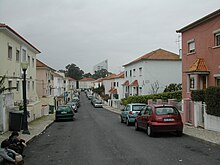Português Suave architecture
Outside of Portugal, this style was also widely used in public buildings of the Portuguese overseas territories in Africa, Asia and Oceania.
The biggest blow to the style was struck by the 1948 1st Portuguese National Congress of Architecture, which meant that it gradually came to be abandoned for both public and private works.
Despite criticism by many intellectuals, the Português Suave architecture proved to be popular, corresponding to the tastes of a segment of the Portuguese people.
Comparing the two typologies, the townhalls are more eclectic and have a freer form, not as tied to ideas of power and austerity of judicial buildings (despite being closely linked to these expressions).
They also have a more historical and nationalist theme associated with them; sometimes there are illustrative panels on the facades, or on the porticoes, relating to various aspects of the city's life, such as its work or its history.
There are several typologies throughout the Portuguese territory; from appearing like urban manors, to the typical classic building, with large turrets topped by high spires.
The building of the Caixa Geral de Depósitos of Santarém shows the austere but sober nature of this functional type.
The fact that throughout the 30s and 40s, a single architect, Adelino Nunes, was responsible for designing these works, left little room for major technical and formal innovations, which reflects in their low diversity.
This fact allows the various facilities built all over the country to be divided in 3 building levels: Simple - for more humble villages, in a more historical-regionalist style.
The primary schools of this period were part of a project known as Escolas dos Centenários by Rogério de Azevedo.
There were small variants that tried to fit the buildings into the architectural panorama of the place where they were located; schools in the south were characterized by arches and whitewashed walls, and in the north by porches and the use of granite.
There was a demand on the part of the State to assert itself on a large scale associated with the need to carry out major works of basic equipment (water, sewage, electricity, road network).
At the same time, buildings of this type were progressive in terms of the technology used (reinforced concrete, pillar-beam-slab system), but traditional in their appearance.
Sometimes there are works in tiles or ceramics with traditional motifs, pieces in wrought iron (flowers, weather vanes and gates).







